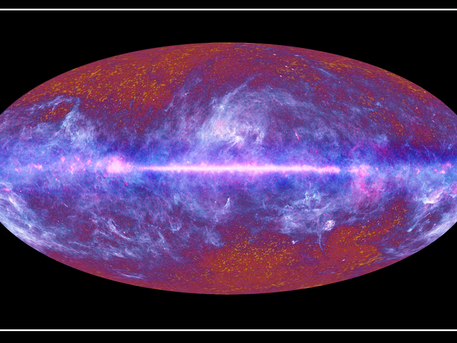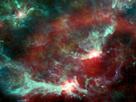First All-Sky-Image
Planck unveils the Universe – now and then
 © ESA/ LFI & HFI Consortia |
This multi-frequency all-sky image of the microwave sky has been composed using data from Planck covering the electromagnetic spectrum from 30 GHz to 857 GHz. The mottled structure of the CMBR, with its tiny temperature fluctuations reflecting the primordial density variations from which today’s cosmic structure originated, is clearly visible in the high-latitude regions of the map. The central band is the plane of our Galaxy. A large portion of the image is dominated by the diffuse emission from its gas and dust. The image was derived from data collected by Planck during its first all-sky survey and comes from observations taken between August 2009 and June 2010. This image is a low- resolution version of the full data set. To the right of the main image, below the plane of the Galaxy, is a large cloud of gas in our Galaxy. The obvious arc of light surrounding it is Barnard’s Loop – the expanding bubble of an exploded star. Planck has seen whole other galaxies. The great spiral galaxy in Andromeda, 2.2 million light-years from Earth, appears as a sliver of microwave light, released by the coldest dust in its giant body. Other, more distant, galaxies with supermassive black holes appear as single points of microwaves dotting the image. Planck was built for ESA by the Prime Contractor Thales Alenia Space (Cannes, France) with contributions from space industry drawn from ESA’s 18 Member States. Because of differing accounting procedures in the many bodies contributing, precise costings are impossible to give. However, the overall cost to ESA and its Member State institutions as well as cooperating agencies world- wide (including NASA and Canadian Space Agency) in round figures is 600M€
From the closest portions of the Milky Way to the furthest reaches of space and time, the new all-sky Planck image is an extraordinary treasure chest of new data for astronomers.
The main disc of our Galaxy runs across the centre of the image. Immediately striking are the streamers of cold dust reaching above and below the Milky Way. This galactic web is where new stars are being formed, and Planck has found many locations where individual stars are edging toward birth or just beginning their cycle of development.
Less spectacular but perhaps more intriguing is the mottled backdrop at the top and bottom. This is the ‘cosmic microwave background radiation’ (CMBR). It is the oldest light in the Universe, the remains of the fireball out of which our Universe sprang into existence 13.7 billion years ago.
While the Milky Way shows us what the local Universe looks like now, those microwaves show us what the Universe looked like close to its time of creation, before there were stars or galaxies. Here we come to the heart of Planck’s mission to decode what happened in that primordial Universe from the pattern of the mottled backdrop.
The microwave pattern is the cosmic blueprint from which today’s clusters and superclusters of galaxies were built. The different colours represent minute differences in the temperature and density of matter across the sky. Somehow these small irregularities evolved into denser regions that became the galaxies of today.
The CMBR covers the entire sky but most of it is hidden in this image by the Milky Way’s emission, which must be digitally removed from the final data in order to see the microwave background in its entirety.
When this work is completed, Planck will show us the most precise picture of the microwave background ever obtained. The big question will be whether the data will reveal the cosmic signature of the primordial period called inflation. This era is postulated to have taken place just after the Big Bang and resulted in the Universe expanding enormously in size over an extremely short period.
Planck continues to map the Universe. By the end of its mission in 2012, it will have completed four all-sky scans. The first full data release of the CMBR is planned for 2012. Before then, the catalogue containing individual objects in our Galaxy and whole distant galaxies will be released in January 2011.
“This image is just a glimpse of what Planck will ultimately see,” says Jan Tauber, ESA’s Planck Project Scientist.
Source: European Space Agency
First All-Sky-Image
Planck unveils the Universe – now and then
 © ESA/ LFI & HFI Consortia |
This multi-frequency all-sky image of the microwave sky has been composed using data from Planck covering the electromagnetic spectrum from 30 GHz to 857 GHz. The mottled structure of the CMBR, with its tiny temperature fluctuations reflecting the primordial density variations from which today’s cosmic structure originated, is clearly visible in the high-latitude regions of the map. The central band is the plane of our Galaxy. A large portion of the image is dominated by the diffuse emission from its gas and dust. The image was derived from data collected by Planck during its first all-sky survey and comes from observations taken between August 2009 and June 2010. This image is a low- resolution version of the full data set. To the right of the main image, below the plane of the Galaxy, is a large cloud of gas in our Galaxy. The obvious arc of light surrounding it is Barnard’s Loop – the expanding bubble of an exploded star. Planck has seen whole other galaxies. The great spiral galaxy in Andromeda, 2.2 million light-years from Earth, appears as a sliver of microwave light, released by the coldest dust in its giant body. Other, more distant, galaxies with supermassive black holes appear as single points of microwaves dotting the image. Planck was built for ESA by the Prime Contractor Thales Alenia Space (Cannes, France) with contributions from space industry drawn from ESA’s 18 Member States. Because of differing accounting procedures in the many bodies contributing, precise costings are impossible to give. However, the overall cost to ESA and its Member State institutions as well as cooperating agencies world- wide (including NASA and Canadian Space Agency) in round figures is 600M€
From the closest portions of the Milky Way to the furthest reaches of space and time, the new all-sky Planck image is an extraordinary treasure chest of new data for astronomers.
The main disc of our Galaxy runs across the centre of the image. Immediately striking are the streamers of cold dust reaching above and below the Milky Way. This galactic web is where new stars are being formed, and Planck has found many locations where individual stars are edging toward birth or just beginning their cycle of development.
Less spectacular but perhaps more intriguing is the mottled backdrop at the top and bottom. This is the ‘cosmic microwave background radiation’ (CMBR). It is the oldest light in the Universe, the remains of the fireball out of which our Universe sprang into existence 13.7 billion years ago.
While the Milky Way shows us what the local Universe looks like now, those microwaves show us what the Universe looked like close to its time of creation, before there were stars or galaxies. Here we come to the heart of Planck’s mission to decode what happened in that primordial Universe from the pattern of the mottled backdrop.
The microwave pattern is the cosmic blueprint from which today’s clusters and superclusters of galaxies were built. The different colours represent minute differences in the temperature and density of matter across the sky. Somehow these small irregularities evolved into denser regions that became the galaxies of today.
The CMBR covers the entire sky but most of it is hidden in this image by the Milky Way’s emission, which must be digitally removed from the final data in order to see the microwave background in its entirety.
When this work is completed, Planck will show us the most precise picture of the microwave background ever obtained. The big question will be whether the data will reveal the cosmic signature of the primordial period called inflation. This era is postulated to have taken place just after the Big Bang and resulted in the Universe expanding enormously in size over an extremely short period.
Planck continues to map the Universe. By the end of its mission in 2012, it will have completed four all-sky scans. The first full data release of the CMBR is planned for 2012. Before then, the catalogue containing individual objects in our Galaxy and whole distant galaxies will be released in January 2011.
“This image is just a glimpse of what Planck will ultimately see,” says Jan Tauber, ESA’s Planck Project Scientist.
Source: European Space Agency








